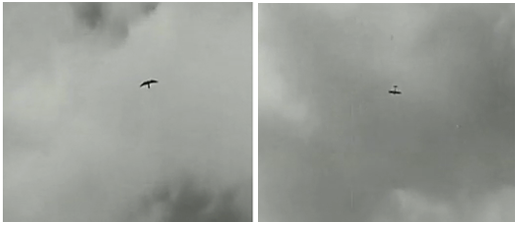
2001 (1968, Kubrick)
Doing research has been one of the most enjoyable parts of keeping this notebook; you never know what nugget you’ll stumble upon. I really got a kick when I happened upon the material for today’s post which is technically 2 shots. Well, I guess it’s 4 shots, because not only am I serving up Kubrick’s stunning editorial truncation of millions of years of human evolution, but I’m also serving Kubrick. Oh, yes, he’s been served. The second shot (or 2 shots) is what Kubrick probably stole from. But no worries. As Oscar Wilde quipped, “Talent imitates, genius steals.” While I don’t believe Kubrick ever commented on or admitted to this, as far as I could find, it’s hard to believe he didn’t get the idea here, consciously or unconsciously.
.
Kubrick steals from the best
Now, everyone is super familiar with the famous, brilliant, awesome, mind-blowingly simple yet profound, etc, match cut transition in 2001 from the pre-historic primate’s bone-throw to the space ship millions of years later. But not many probably know the shot from Powell/Pressburger’s A Cantebury Tale (1944) — including myself, until I stumbled upon it doing research for the recent post on Deliverance, of all things. Surely Kubrick would have seen this and remembered it on some level. It must have inspired Kubrick’s master stroke.
.
.
In the 1944 application of the technique, we leap centuries in one edit. Check out how cool and ahead of its time this cut is – a falcon turns into an airplane. Military technology jumps 600 years. Pretty bold and cool. It’s in the youtube video at 3:17.
.
.
As cool as that is, Kubrick was able to give the same technique an even deeper resonance. Instead of centuries, it’s millions of years, and the entire evolution of mankind and its use of tools are expressed in one-twenty-fourth of a second by way of a single edit. Doesn’t get more efficient than that, does it? That’s what a director is always striving for, to communicate the most information in the simplest way, with the greatest story impact. Earth to Kubrick, mission accomplished.
.


Herr Nemes
The man was a genius. May his bones rest in peace.
jsbfilm
Didn’t you hear? His bones all turned into space ships. It was profound.
jeremy Cole
Yeah, that’s a good’n. Curious to notice that he chose NOT to do a more precise match cut from the bone to the ship. Looks like he could have. Perhaps he thought it was too cute?
What really grabs me about the whole sequence is how much thought went into the actual functioning of this imagined future. The practicality imposed by physics on the design of the station, the velcro shoes, the hair bonnet, the docking procedure, the scalable design of the station (one ring at a time). Even the cylindrical elevator seems to take into account the rotation of the station and the need to sync up to it (I don’t remember exactly where he gets off). That kind of detail really resonates for me. It doesn’t lean on suspension of disbelief to get by. It goes the other way. All the thought and consistent details add up to a perception that you’re seeing something completely foreign, yet real. I dig that.
jsbfilm
Hey, Jeremy, I wondered where you’ve been. Welcome back. Yeah, I think the exact matching of the cut would have been distracting and, what’s more, beside the point. It’s almost like he was thinking, this is so f’n profound, I don’t have to do nothing but juxtapose these two shots. Also, there’s a crudeness (obviously) to the bone, flailing madly through the air, while the ship or satellite is so refined and steady. That’s an important contrast too, I believe.
torsloke
I’d be more remiss to make the strong accusation this of being an explicit theft without further evidence. Here’s the exculpatory evidence:
– I don’t know that it’s even likely Kubrick saw this film. He was only 16 when it came out, it was poorly reviewed and the least successful of Michael Powell’s early films.
– Even if he did, there’s considerably more artistry in his version. Making the analogy “a plane is like a bird” seems considerably less profound than “primitive man’s discovery of weapons is analogous in terms of humankind’s evolution to modern man’s exploration of space”.
I feel like the accusation overshadows the examination of what should be the focus here – Kubrick’s daring visual narrative.
jsbfilm
Oh, Ry, keeping the pot stirred, you! I think it’s easily possible, even likely, that in contemplating his (now more famous) transition, Kubrick or someone close to him remembered that amazing moment by P/P. I mean, it’s the exact same concept. How to show the passage of an evolution…both having to do with tools of mankind. I think Kubrick had an inherently stronger application of the same technique (by very nature of his canvas and story) but both serve their material very well.
Though you’re right. There’s no real evidence he was inspired directly.
Pingback: JEZEBEL (1938, Wyler) « shot4shot